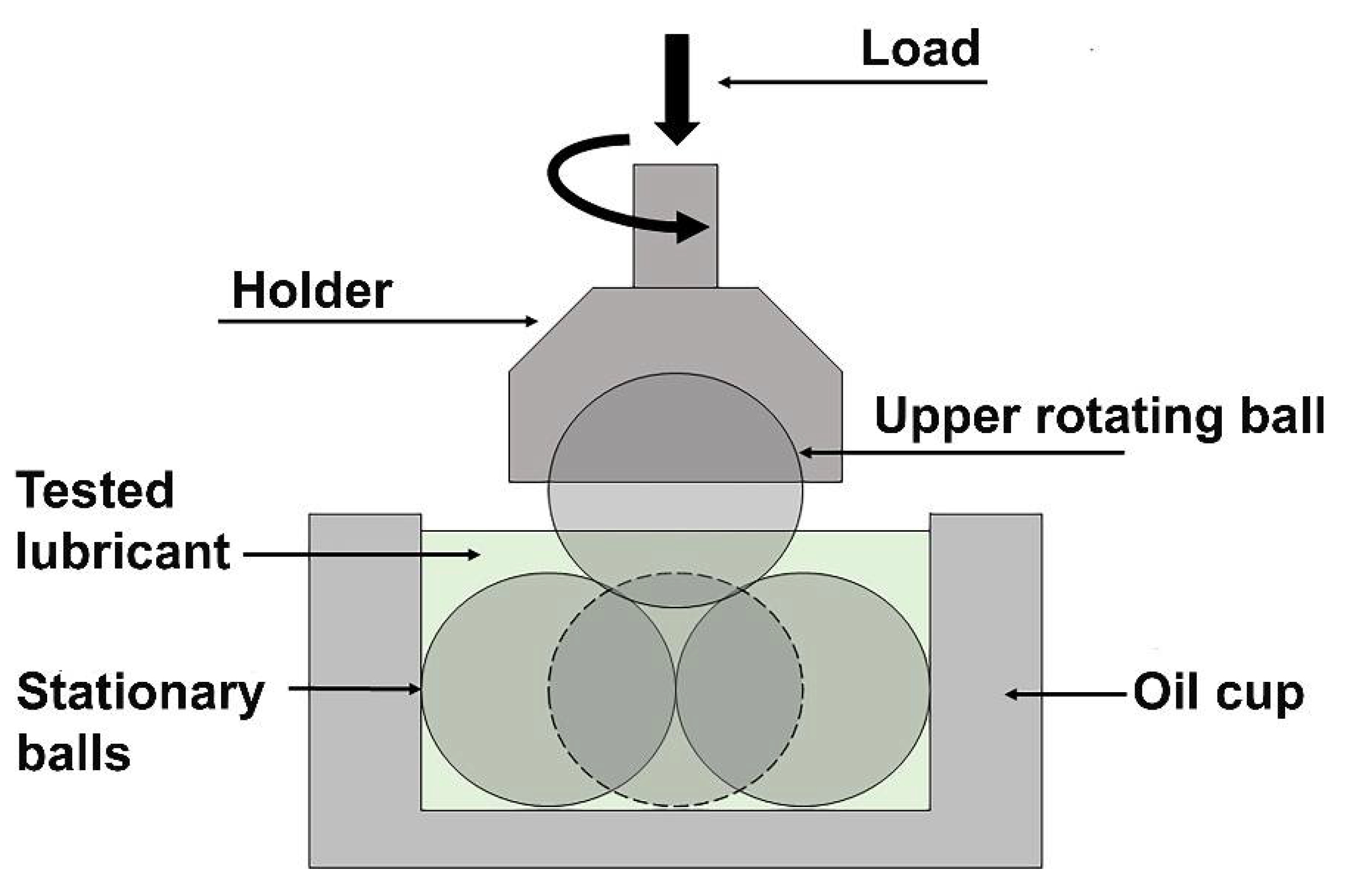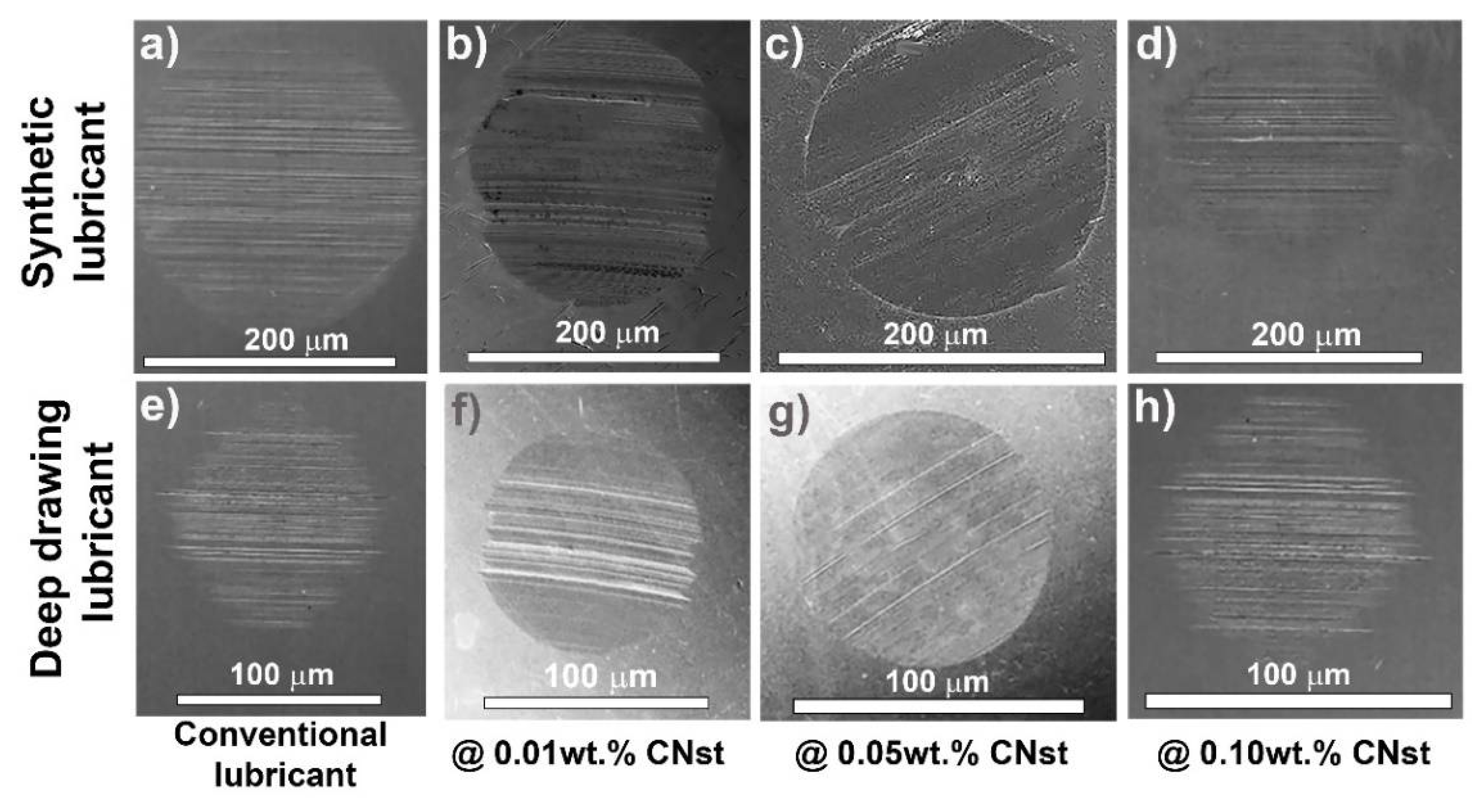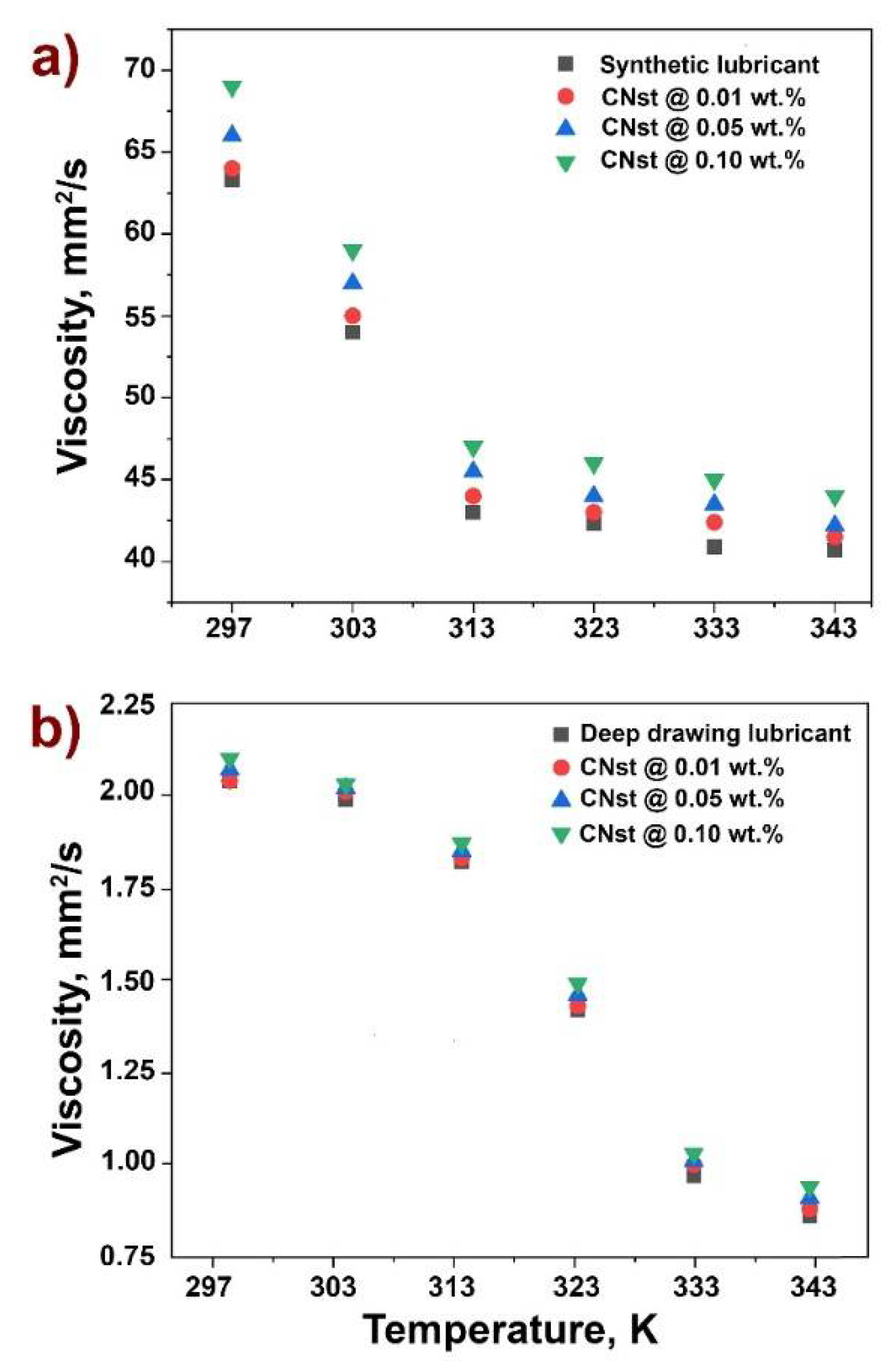Carbon Nanotori Reinforced Lubricants in Plastic Deformation Processes
Abstract
:1. Introduction
2. Materials and Methods
Nanolubricants Preparation
3. Experimental Details
3.1. Tribological Evaluations
3.2. Viscosity Evaluations
4. Results and Discussion
4.1. Tribological Performance
4.2. Viscosity Evaluations
5. Conclusions
Author Contributions
Funding
Institutional Review Board Statement
Informed Consent Statement
Data Availability Statement
Acknowledgments
Conflicts of Interest
References
- Taha-Tijerina, J.J.; Calderón, R.; Rodríguez, B. Optimization and nanoreinforcements of lubricant Concentration for steel sheet forming process. Int. J. Mod. Manuf. Technol. 2021, 13, 137–142. [Google Scholar] [CrossRef]
- Chai, Y.; Yusup, S.; Chok, V. A Review on Nanoparticle Addition in Base Fluid for Improvement of Biodegradable Ester-Based Drilling Fluid Properties. Chem. Eng. Trans. 2015, 45, 1447–1452. [Google Scholar]
- Rout, I.S.; Sahoo, M. Optimization of Drilling Parameters Using Nanofluid MinimumQuantity Lubrication. Int. J. Emerg. Technol. Adv. Eng. 2016, 6, 27–34. [Google Scholar]
- Minh, D.T.; The, L.T.; Bao, N.T. Performance of Al2O3 nanofluids in minimum quantity lubrication in hard milling of 60Si2Mn steel using cemented carbide tools. Adv. Mech. Eng. 2017, 9, 1–9. [Google Scholar] [CrossRef] [Green Version]
- Zareh-Desari, B.; Davoodi, B. Assessing the lubrication performance of vegetable oil-based nano-lubricants for environmentally conscious metal forming processes. J. Clean. Prod. 2016, 135, 1198–1209. [Google Scholar] [CrossRef]
- Zhang, Y.; Li, H.N.; Li, C.; Huang, C.; Ali, H.M.; Xu, X. Nano-enhanced biolubricant in sustainable manufacturing: From processability to mechanisms. Friction 2021, 10, 803–841. [Google Scholar] [CrossRef]
- Morshed, A.; Wu, H.; Jiang, Z. A Comprehensive Review of Water-Based Nanolubricants. Lubricants 2021, 9, 89. [Google Scholar] [CrossRef]
- Babu, M.N.; Anandan, V.; Babu, M.D.; Muthukrishnan, N. Turning SKD 11 Steel Using Silver Nanofluids with Minimum Quantity Lubrication. Int. J. Manuf. Mater. 2021, 11, 74–95. [Google Scholar] [CrossRef]
- Chinchanikar, S.; Kore, S.S.; Hujare, P. A review on nanofluids in minimum quantity lubrication machining. J. Manuf. Process. 2021, 68, 56–70. [Google Scholar] [CrossRef]
- Tang, H.; Sun, J.; He, J.; Wu, P. Research Progress of Interface Conditions and Tribological Reactions: A Review. J. Ind. Eng. Chem. 2021, 94, 105–121. [Google Scholar] [CrossRef]
- Sharma, A.K.; Tiwari, A.K.; Dixit, A.R. Progress of Nanofluid Application in Machining: A Review. Mater. Manuf. Process. 2015, 30, 813–828. [Google Scholar] [CrossRef]
- Ben Said, L.; Kolsi, L.; Ghachem, K.; Almeshaal, M.; Maatki, C. Application of nanofluids as cutting fluids in machining operations: A brief review. Appl. Nanosci. 2021, 1–32. [Google Scholar] [CrossRef]
- Kishawy, H.A.; Hegab, H.; Deiab, I.; Eltaggaz, A. Sustainability assessment during machining Ti-6Al-4V with nano-additives-based minimum quantity lubrication. J. Manuf. Mater. Process. 2019, 3, 61. [Google Scholar] [CrossRef] [Green Version]
- Kadirgama, K. A comprehensive review on the application of nanofluids in the machining process. Int. J. Adv. Manuf. Technol. 2021, 115, 2669–2681. [Google Scholar] [CrossRef]
- Reverberi, A.P.; D’Addona, D.M.; Bruzzone, A.A.G.; Teti, R.; Fabiano, B. Nanotechnology in machining processes: Recent advances. Procedia CIRP 2019, 79, 3–8. [Google Scholar] [CrossRef]
- Guo, D.; Xie, G.; Luo, J. Mechanical properties of nanoparticles: Basics and applications. J. Phys. D Appl. Phys. 2014, 47, 13001. [Google Scholar] [CrossRef] [Green Version]
- Bai, M.J.; Liu, J.L.; Qi, Z.N.; He, J.; Wei, J.J.; Miao, J.Y. Research progress in nanofluids with graphene addition. J. Mater. Eng. 2020, 48, 46–59. [Google Scholar]
- Delgado, J.L.; Herranz, M.Á.; Martín, N. The nano-forms of carbon. J. Mater. Chem. 2008, 18, 1417–1426. [Google Scholar] [CrossRef]
- Liu, L.; Zhao, J. Toroidal and Coiled Carbon Nanotubes. In Syntheses and Applications of Carbon Nanotubes and Their Composites; Suzuki, S., Ed.; IntechOpen: London, UK, 2013. [Google Scholar]
- Sarapat, P.; Hill, J.; Baowan, D. A Review of Geometry, Construction and Modelling for Carbon Nanotori. Appl. Sci. 2019, 9, 2301. [Google Scholar] [CrossRef] [Green Version]
- Jammoria, N.S.; Ul Haq, M.I.; Raina, A. Carbon-Related Materials for Tribological Application. In Advances in Sustainability Science and Technology, Proceedings of Fourth International Conference on Inventive Material Science Applications, Coimbatore, India, 4–15 May 2021; Springer: Singapore, 2022; pp. 469–483. [Google Scholar]
- Shafi, W.K.; Charoo, M.S. An overall review on the tribological, thermal and rheological properties of nanolubricants. Tribol.-Mater. Surf. Interfaces 2020, 15, 20–54. [Google Scholar] [CrossRef]
- Opia, A.C.; Kameil, A.H.M.; Syahrullail, S.; Johnson, C.A.N.; Izmi, M.I.; Mamah, S.C. Tribological behavior of organic formulated anti-wear additive under high frequency reciprocating rig and unidirectional orientations: Particles transport behavior and film formation mechanism. Tribol. Int. 2022, 167, 107415. [Google Scholar] [CrossRef]
- Chen, Y.; Yang, K.; Lin, H.; Zhang, F.; Xiong, B.; Zhang, H. Important contributions of multidimensional nanoadditives on the tribofilms: From formation mechanism to tribological behaviors. Compos. Part B Eng. 2022, 234, 109732. [Google Scholar] [CrossRef]
- Jason, Y.J.J.; How, H.G.; Teoh, Y.H.; Chuah, H.G. A Study on the Tribological Performance of Nanolubricants. Processes 2020, 8, 1372. [Google Scholar] [CrossRef]
- Jansson, N. Carbon Nanostructures as Lubricant Additives. Master’s Thesis, Norwegian University of Science and Technology, Trondheim, Norway, 2021. [Google Scholar]
- Ali, I.; Basheer, A.A.; Kucherova, A.; Memetov, N.; Pasko, T.; Ovchinnikov, K. Advances in carbon nanomaterials as lubricants modifiers. J. Mol. Liq. 2019, 279, 251–266. [Google Scholar] [CrossRef]
- Rasheed, A.K.; Khalid, M.; Javeed, A.; Rashmi, W.; Gupta, T.C.S.M.; Chan, A. Heat transfer and tribological performance of graphene nanolubricant in an internal combustion engine. Tribol. Int. 2016, 103, 504–515. [Google Scholar] [CrossRef]
- Bhaumik, S.; Prabhu, S.; Singh, K.J. Analysis of Tribological behavior of carbon nanotube based industrial mineral gear oil 250 cSt viscosity. Adv. Tribol. 2014, 2014, 341365. [Google Scholar] [CrossRef] [Green Version]
- Peña-Parás, L.; Taha-Tijerina, J.; García, A.; Maldonado, D.; González, J.A.; Molina, D. Antiwear and Extreme Pressure Properties of Nanofluids for Industrial Applications. Tribol. Trans. 2014, 57, 1072–1076. [Google Scholar] [CrossRef]
- Kumar, N.; Goyal, P. Experimental study of Carbon Nanotubes to enhance Tribological Characteristics of Lubricating Engine Oil SAE 10W40. IOP Conf. Ser. Mater. Sci. Eng. 2022, 1225, 012052. [Google Scholar] [CrossRef]
- Mohamed, A.; Osman, T.A.; Khattab, A.; Zaki, M. Tribological behavior of carbon nanotubes as an additive on lithium grease. J. Tribol. 2015, 137, 011801. [Google Scholar] [CrossRef]
- Peña-Parás, L.; Taha-Tijerina, J.; García, A.; Maldonado, D.; Nájera, A.; Cantú, P. Thermal transport and tribological properties of nanogreases for metal-mechanic applications. Wear 2015, 332–333, 1322–1326. [Google Scholar] [CrossRef]
- Ni, B.; Sinnott, S.B. Tribological properties of carbon nanotube bundles predicted from atomistic simulations. Surf. Sci. 2001, 487, 87–96. [Google Scholar] [CrossRef]
- Senatore, A.; Hong, H.; D’urso, V.; Younes, H. Tribological Behavior of Novel CNTs-Based Lubricant Grease in Steady-State and Fretting Sliding Conditions. Lubricants 2021, 9, 107. [Google Scholar] [CrossRef]
- Mishra, P.C.; Mukherjee, S.; Nayak, S.K.; Panda, A. A brief review on viscosity of nanofluids. Int. Nano Lett. 2014, 4, 109–120. [Google Scholar] [CrossRef] [Green Version]
- Hamze, S.; Cabaleiro, D.; Estellé, P. Graphene-based nanofluids: A comprehensive review about rheological behavior and dynamic viscosity. J. Mol. Liq. 2021, 325, 115207. [Google Scholar] [CrossRef]
- Koca, H.D.; Doganay, S.; Turgut, A.; Tavman, I.H.; Saidur, R.; Mahbubul, I.M. Effect of particle size on the viscosity of nanofluids: A review. Renew. Sustain. Energy Rev. 2018, 82, 1664–1674. [Google Scholar] [CrossRef] [Green Version]
- Rubbi, F.; Das, L.; Habib, K.; Aslfattahi, N.; Saidur, R.; Alam, S.U. A comprehensive review on advances of oil-based nanofluids for concentrating solar thermal collector application. J. Mol. Liq. 2021, 338, 116771. [Google Scholar] [CrossRef]
- Sadeghinezhad, E.; Mehrali, M.; Tahan, L.S.; Mehrali, M.; Kazi, S.N.; Oon, C.S. Experimental investigation of convective heat transfer using graphene nanoplatelet based nanofluids under turbulent flow conditions. Ind. Eng. Chem. Res. 2014, 53, 12455–12465. [Google Scholar] [CrossRef]
- Moghaddam, M.B.; Goharshadi, E.K.; Entezari, M.H.; Nancarrow, P. Preparation, characterization, and rheological properties of graphene-glycerol nanofluids. Chem. Eng. J. 2013, 231, 365–372. [Google Scholar] [CrossRef]
- Afrand, M.; Nazari Najafabadi, K.; Akbari, M. Effects of temperature and solid volume fraction on viscosity of SiO2-MWCNTs/SAE40 hybrid nanofluid as a coolant and lubricant in heat engines. Appl. Therm. Eng. 2016, 102, 45–54. [Google Scholar] [CrossRef]
- Dhanola, A.; Garg, H.C. Dispersion stability and rheology study of canola oil containing TiO2 nanoadditives for tribological applications: An experimental approach. Proc. Inst. Mech. Eng. Part J J. Eng. Tribol. 2020, 235, 1765–1781. [Google Scholar] [CrossRef]
- Liu, J.; Dai, H.; Hafner, J.H.; Colbert, D.T.; Smalley, R.E. Fullerene “crop circles”. Nature 1997, 385, 780–781. [Google Scholar] [CrossRef]
- Taha-Tijerina, J.; Aviña, K.; Martínez, J.M.; Arquieta-Guillén, P.Y.; González-Escobedo, M. Carbon Nanotori Structures for Thermal Transport Applications on Lubricants. Nanomaterials 2021, 11, 1158. [Google Scholar] [CrossRef] [PubMed]
- Liu, L.; Guo, G.Y.; Jayanthi, C.S.; Wu, S.Y. Colossal Paramagnetic Moments in Metallic Carbon Nanotori. Phys. Rev. Lett. 2002, 88, 217206. [Google Scholar] [CrossRef] [PubMed] [Green Version]
- Kharissova, O.V.; Garza-Castañón, M.; Kharisov, B.I. Inorganic nanorings and nanotori: State of the art. J. Mater. Res. 2019, 34, 3998–4010. [Google Scholar] [CrossRef]
- Michalczewski, R.; Piekoszewski, W.; Tuszynski, W.; Szczerek, M.; Wulczynski, J. The new methods for scuffing and pitting investigation of coated materials for heavy loaded lubricated elements. In Tribology—Lubricants and Lubrication; Kuo, C.-H., Ed.; InTech: Rijeka, Croatia, 2011; pp. 305–320. [Google Scholar]
- Szczerek, M.; Tuszynski, W. A method for testing lubricants under conditions of scuffing. Part I. Presentation of the method. Tribotest 2002, 8, 273–284. [Google Scholar] [CrossRef]
- Rudnick, L.R. Synthetics, Mineral Oils, and Bio-Based Lubricants: Chemistry and Technology; CRC Press: Boca Raton, FL, USA, 2020; p. 1194. [Google Scholar]
- Tóth, Á.D.; Szabó, Á.I.; Leskó, M.Z.; Rohde-Brandenburger, J.; Kuti, R. Tribological Properties of the Nanoscale Spherical Y2O3 Particles as Lubricant Additives in Automotive Application. Lubricants 2022, 10, 28. [Google Scholar] [CrossRef]
- Hernández-Battez, A.; González, R.; Viesca, J.L.; Fernández, J.E.; Díaz-Fernández, J.M.; Machado, A. CuO, ZrO2 and ZnO nanoparticles as antiwear additive in oil lubricants. Wear 2008, 265, 422–428. [Google Scholar] [CrossRef]
- Kato, H.; Komai, K. Tribofilm formation and mild wear by tribo-sintering of nanometer-sized oxide particles on rubbing steel surfaces. Wear 2007, 262, 36–41. [Google Scholar] [CrossRef]
- Rabaso, P.; Ville, F.; Dassenoy, F.; Diaby, M.; Afanasiev, P.; Cavoret, J. Boundary lubrication: Influence of the size and structure of inorganic fullerene-like MoS2 nanoparticles on friction and wear reduction. Wear 2014, 320, 161–178. [Google Scholar] [CrossRef]
- Ali, N.; Bahman, A.M.; Aljuwayhel, N.F.; Ebrahim, S.A.; Mukherjee, S.; Alsayegh, A. Carbon-based nanofluids and their advances towards heat transfer applications—A review. Nanomaterials 2021, 11, 1628. [Google Scholar] [CrossRef]
- Ibrahim, M.; Saeed, T.; Chu, Y.M.; Ali, H.M.; Cheraghian, G.; Kalbasi, R. Comprehensive study concerned graphene nano-sheets dispersed in ethylene glycol: Experimental study and theoretical prediction of thermal conductivity. Powder Technol. 2021, 386, 51–59. [Google Scholar] [CrossRef]
- Rasheed, A.K.; Khalid, M.; Rashmi, W.; Gupta, T.C.S.M.; Chan, A. Graphene based nanofluids and nanolubricants–Review of recent developments. Renew. Sustain. Energy Rev. 2016, 63, 346–362. [Google Scholar] [CrossRef]
- Kamel, B.M.; Tirth, V.; Algahtani, A.; Shiba, M.S.; Mobasher, A.; Hashish, H.A. Optimization of the Rheological Properties and Tribological Performance of SAE 5W-30 Base Oil with Added MWCNTs. Lubricants 2021, 9, 94. [Google Scholar] [CrossRef]



| Materials | Properties | ||
|---|---|---|---|
| Base lubricant | Density (15 °C) | Kinetic Viscosity (mm2/s) | Water: oil ratio 4:1 |
| Deep-drawing (DD) | 0.967 g/cm3 | 2.02 @ 24 °C; 0.86 @ 70 °C | |
| Synthetic (SL) | 1.033 g/cm3 | 63.3 @ 24 °C; 40.7 @ 70 °C | 6:1 |
| Nanoparticles | Size | Polydispersity index | Zeta potential |
| Carbon Nanotori structures (CNst) | Torus diameter ~130 nm Tube diameter ~40 nm | 0.248 | −26.5 mV |
| Lubricant | Seizure Load, Poz (N) | Load-Carrying Capacity, poz (N/mm2) (Enhancement) | WSD (mm) (Reduction) |
|---|---|---|---|
| Synthetic lubricant (SL) | 4950 | 705 | 1.93 |
| @ 0.01 wt.% CNst | 5435 | 826 (16%) | 1.85 (4%) |
| @ 0.05 wt.% CNst | 5760 | 1007 (42%) | 1.72 (10%) |
| @ 0.10 wt.% CNst | 6150 | 1218 (73%) | 1.62 (16%) |
| Deep drawing lubricant (DD) | 6100 | 3300 | 0.98 |
| @ 0.01 wt.% CNst | 6400 | 4018 (22%) | 0.91 (7%) |
| @ 0.05 wt.% CNst | 6700 | 5055 (53%) | 0.83 (15%) |
| @ 0.10 wt.% CNst | 7200 | 6840 (107%) | 0.74 (24%) |
Publisher’s Note: MDPI stays neutral with regard to jurisdictional claims in published maps and institutional affiliations. |
© 2022 by the authors. Licensee MDPI, Basel, Switzerland. This article is an open access article distributed under the terms and conditions of the Creative Commons Attribution (CC BY) license (https://creativecommons.org/licenses/by/4.0/).
Share and Cite
Taha-Tijerina, J.J.; Martínez, J.M.; Euresti, D.; Arquieta-Guillén, P.Y. Carbon Nanotori Reinforced Lubricants in Plastic Deformation Processes. Lubricants 2022, 10, 74. https://doi.org/10.3390/lubricants10050074
Taha-Tijerina JJ, Martínez JM, Euresti D, Arquieta-Guillén PY. Carbon Nanotori Reinforced Lubricants in Plastic Deformation Processes. Lubricants. 2022; 10(5):74. https://doi.org/10.3390/lubricants10050074
Chicago/Turabian StyleTaha-Tijerina, Jose Jaime, Juan Manuel Martínez, Daniel Euresti, and Patsy Yessenia Arquieta-Guillén. 2022. "Carbon Nanotori Reinforced Lubricants in Plastic Deformation Processes" Lubricants 10, no. 5: 74. https://doi.org/10.3390/lubricants10050074
APA StyleTaha-Tijerina, J. J., Martínez, J. M., Euresti, D., & Arquieta-Guillén, P. Y. (2022). Carbon Nanotori Reinforced Lubricants in Plastic Deformation Processes. Lubricants, 10(5), 74. https://doi.org/10.3390/lubricants10050074






